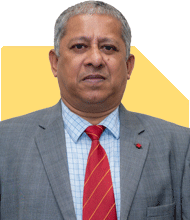Ramalingam Kalirajan |8292 Answers |Ask -Follow
Mutual Funds, Financial Planning Expert - Answered on Jun 25, 2024
He has an MBA in finance from the University of Madras and is a certified financial planner.
He is the director and chief financial planner at Holistic Investment, a Chennai-based firm that offers financial planning and wealth management advice.... more

I’m 36year old working female. I’m living a comfortable life and ensure one international vacation annually. I plan to retire by 45 years of age and continue with similar lifestyle. I have following savings, please suggest what adjustments should I make and whether my savings are reasonable for my age. I have no kids, no loans and no property in my name. I live in my family home. Equity- 88lac Savings account- 48lac PF+EPF- 35 lac Gold 9 lac Insurance policy - 2.5 lac Crypto 1.5 lac
Current Financial Snapshot
Let’s summarize your current financial position:
Equity Investments: Rs 88 lakhs
Savings Account: Rs 48 lakhs
Provident Fund (PF) + Employee Provident Fund (EPF): Rs 35 lakhs
Gold: Rs 9 lakhs
Insurance Policy: Rs 2.5 lakhs
Cryptocurrency: Rs 1.5 lakhs
Analysis of Current Savings
Equity Investments
You have Rs 88 lakhs in equity investments. This is a strong component of your portfolio, given its potential for high returns over the long term.
Savings Account
Having Rs 48 lakhs in a savings account is a significant amount. While it's good to have liquidity, savings accounts offer low returns, which may not keep up with inflation.
Provident Fund and EPF
Your PF and EPF holdings amount to Rs 35 lakhs. These are crucial for your retirement as they provide stability and guaranteed returns.
Gold
Gold worth Rs 9 lakhs is a good hedge against inflation and adds diversity to your portfolio. However, its returns are generally lower compared to equities.
Insurance Policy
You have an insurance policy worth Rs 2.5 lakhs. Ensure this is purely a term insurance policy for adequate risk cover.
Cryptocurrency
Your cryptocurrency investment is Rs 1.5 lakhs. This is a highly volatile and unregulated market. It’s essential to be cautious with this part of your portfolio.
Steps to Achieve Your Retirement Goal by 45
Increase Equity Investments
Given your age and the time horizon until retirement, continuing with a strong equity exposure is advisable. Equities generally provide higher returns over the long term.
Diversify Across Sectors: Ensure your equity portfolio is diversified across various sectors and industries to reduce risk.
Regular Monitoring: Keep an eye on the performance of your stocks and make adjustments as needed.
Rebalance Savings Account
Having Rs 48 lakhs in a savings account is quite high. Consider reallocating a portion of these funds to higher-return investments.
Emergency Fund: Maintain an emergency fund of 6-12 months of your expenses in a savings account or liquid funds.
Invest the Rest: Reallocate excess funds into mutual funds or other diversified investment options for better returns.
Maximize Provident Fund and EPF
Your PF and EPF are safe, low-risk investments. Continue maximizing your contributions to these funds.
EPF Voluntary Contributions: If possible, consider voluntary contributions to EPF for additional tax benefits and secure returns.
Evaluate Gold Holdings
Gold is a good investment for diversification but doesn’t generate income. Consider the following:
Hold or Reallocate: Evaluate if you need to hold the entire amount in gold or reallocate a portion to higher-growth investments.
Review Insurance Policy
Ensure your insurance policy is a term policy providing adequate coverage.
Term Insurance: If it’s not a term insurance policy, consider switching to a term policy with adequate coverage for your needs.
Assess Cryptocurrency Investment
Cryptocurrency is highly volatile and unregulated. While it can offer high returns, it comes with significant risk.
Limit Exposure: Keep your exposure to cryptocurrency minimal to safeguard against potential losses.
Adjustments for Better Financial Health
Consolidate and Reinvest Direct Stocks
Direct stocks can be high-risk if not managed properly. Consider consolidating and reinvesting in mutual funds.
Actively Managed Funds: Invest through mutual funds managed by professional fund managers. This provides better risk management and diversification.
Regular Monitoring: Regularly review and rebalance your mutual fund portfolio to align with your financial goals.
Increase Monthly Investments
If you have surplus income, consider increasing your monthly investments.
SIP in Mutual Funds: Systematic Investment Plans (SIPs) in mutual funds are an excellent way to invest regularly and benefit from rupee cost averaging.
Diversified Portfolio: Choose a mix of large-cap, mid-cap, and small-cap funds for a balanced portfolio.
Planning for Early Retirement
Estimate Retirement Corpus
To maintain your current lifestyle, estimate the corpus required. Consider factors like inflation, healthcare costs, and lifestyle expenses.
Retirement Corpus: Aim for a retirement corpus that generates enough returns to sustain your lifestyle without depleting the principal amount.
Retirement Investment Strategy
Once you retire, your investment strategy should shift towards preserving capital while generating income.
Balanced Funds: Consider balanced or hybrid funds that offer a mix of equity and debt for stability and growth.
SWP (Systematic Withdrawal Plan): Use SWPs from mutual funds to generate a regular income post-retirement.
Professional Guidance
A Certified Financial Planner (CFP) can provide tailored advice and help you navigate complex financial decisions.
Customized Plan: A CFP can create a customized retirement plan based on your unique goals and risk tolerance.
Regular Reviews: They can also help in regular monitoring and rebalancing of your portfolio to ensure it stays on track.
Importance of Diversification
Diversifying your investments across different asset classes can reduce risk and improve returns.
Asset Allocation: Maintain a balanced asset allocation between equity, debt, and gold based on your risk profile and time horizon.
Regular Rebalancing: Periodically rebalance your portfolio to maintain the desired asset allocation.
Final Insights
Your proactive approach to financial planning is impressive. To ensure you meet your goal of retiring by 45 with a comfortable lifestyle, consider the following steps:
Increase Equity Investments: Continue focusing on equities for higher long-term returns.
Rebalance Savings: Reallocate excess funds from your savings account to higher-return investments.
Maximize PF and EPF: Continue maximizing your contributions to these secure, low-risk funds.
Evaluate Gold Holdings: Consider if reallocating a portion of your gold investments is necessary.
Review Insurance Policy: Ensure your insurance provides adequate coverage.
Limit Cryptocurrency Exposure: Keep your exposure minimal due to high volatility and risk.
Consolidate Direct Stocks: Reinvest in mutual funds for better risk management and diversification.
Increase Monthly Investments: Consider increasing your SIPs for better long-term growth.
Seek Professional Guidance: A CFP can provide valuable insights and tailored advice.
By following these steps and maintaining your disciplined approach, you can achieve your goal of retiring by 45 and enjoying a comfortable lifestyle.
Best Regards,
K. Ramalingam, MBA, CFP,
Chief Financial Planner,
www.holisticinvestment.in
You may like to see similar questions and answers below
Ramalingam Kalirajan |8292 Answers |Ask -Follow
Mutual Funds, Financial Planning Expert - Answered on Apr 23, 2024
Ramalingam Kalirajan |8292 Answers |Ask -Follow
Mutual Funds, Financial Planning Expert - Answered on Aug 08, 2024
Ramalingam Kalirajan |8292 Answers |Ask -Follow
Mutual Funds, Financial Planning Expert - Answered on Jan 20, 2025
Prof Suvasish Mukhopadhyay |598 Answers |Ask -Follow
Career Counsellor - Answered on Apr 27, 2025
Nayagam P P |4465 Answers |Ask -Follow
Career Counsellor - Answered on Apr 27, 2025
Nayagam P P |4465 Answers |Ask -Follow
Career Counsellor - Answered on Apr 27, 2025
Radheshyam Zanwar |1575 Answers |Ask -Follow
MHT-CET, IIT-JEE, NEET-UG Expert - Answered on Apr 27, 2025

Yes, you can apply through both JEE Main and NFAT to maximize your chances. While filling the application form, select both options if available, or submit two separate applications if required. But it would be better to carefully read the instructions on the application portal or contact the admission office for exact steps.
Follow me if you like the reply. Thanks
Radheshyam
Prof Suvasish Mukhopadhyay |598 Answers |Ask -Follow
Career Counsellor - Answered on Apr 27, 2025
Prof Suvasish Mukhopadhyay |598 Answers |Ask -Follow
Career Counsellor - Answered on Apr 27, 2025
Prof Suvasish Mukhopadhyay |598 Answers |Ask -Follow
Career Counsellor - Answered on Apr 27, 2025
Radheshyam Zanwar |1575 Answers |Ask -Follow
MHT-CET, IIT-JEE, NEET-UG Expert - Answered on Apr 27, 2025
Dr Dipankar Dutta |1173 Answers |Ask -Follow
Tech Careers and Skill Development Expert - Answered on Apr 26, 2025

Newer IIITs (Una, Ranchi, Bhagalpur) CSE/IT
Dr Dipankar Dutta |1173 Answers |Ask -Follow
Tech Careers and Skill Development Expert - Answered on Apr 26, 2025










.jpg)









